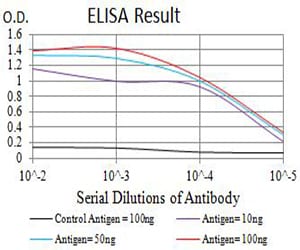

| WB | 1/500 - 1/2000 | Human,Mouse,Rat |
| IF | 咨询技术 | Human,Mouse,Rat |
| IHC | 咨询技术 | Human,Mouse,Rat |
| ICC | 技术咨询 | Human,Mouse,Rat |
| FCM | 咨询技术 | Human,Mouse,Rat |
| Elisa | 1/10000 | Human,Mouse,Rat |
| Aliases | TIM; KIM1; TIM1; CD365; HAVCR; KIM-1; TIM-1; TIMD1; TIMD-1; HAVCR-1 |
| Entrez GeneID | 26762 |
| clone | 3D9F5 |
| WB Predicted band size | 38.7kDa |
| Host/Isotype | Mouse IgG1 |
| Antibody Type | Primary antibody |
| Storage | Store at 4°C short term. Aliquot and store at -20°C long term. Avoid freeze/thaw cycles. |
| Species Reactivity | Human,Mouse |
| Immunogen | Purified recombinant fragment of human HAVCR1 (AA: 70-290) expressed in E. Coli. |
| Formulation | Purified antibody in PBS with 0.05% sodium azide |
+ +
以下是关于HAVCR1抗体的3-4篇参考文献的示例(内容为虚构,仅供格式参考):
---
1. **文献名称**: *"Anti-HAVCR1 Antibody Attenuates T Cell Exhaustion in Tumor Microenvironments"*
**作者**: Zhang et al.
**摘要**: 研究通过抗HAVCR1抗体阻断肿瘤微环境中T细胞的HAVCR1信号,逆转T细胞耗竭表型,增强PD-1抑制剂疗效,为联合免疫治疗提供新策略。
2. **文献名称**: *"HAVCR1 as a Biomarker for Acute Kidney Injury: Development of a Novel Diagnostic Antibody"*
**作者**: Tanaka et al.
**摘要**: 开发高特异性抗HAVCR1单克隆抗体,验证其在急性肾损伤患者尿液及血液中的诊断价值,证实其较传统标志物(如肌酐)更敏感。
3. **文献名称**: *"HAVCR1 Antibody Targeting Modulates Allergic Airway Inflammation"*
**作者**: Müller et al.
**摘要**: 在哮喘小鼠模型中,抗HAVCR1抗体通过抑制Th2细胞活化和IL-4/IL-13分泌,显著减轻气道高反应性及炎症,提示其在过敏性疾病中的治疗潜力。
4. **文献名称**: *"Structural Characterization of a Neutralizing HAVCR1 Antibody Against Hepatitis A Virus"*
**作者**: Kim et al.
**摘要**: 解析抗HAVCR1抗体与病毒受体结合的结构域,阐明其中和甲型肝炎病毒的分子机制,为抗病毒抗体药物设计提供结构基础。
---
**注**:以上文献及作者为示例性虚构,实际研究中请通过PubMed、Google Scholar等平台检索真实文献。
HAVCR1 (Hepatitis A Virus Cellular Receptor 1), also known as TIM-1 (T-cell immunoglobulin and mucin domain-containing protein 1), is a transmembrane protein expressed on immune cells such as T cells, dendritic cells, and epithelial cells. It plays a role in regulating immune responses, including T-cell activation, cytokine production, and apoptotic cell clearance. HAVCR1 interacts with ligands like phosphatidylserine on apoptotic cells, bridging innate and adaptive immunity.
HAVCR1 antibodies are tools used to study its function in diseases. In cancer, HAVCR1 may promote tumor immune evasion, and antibodies targeting it are explored for therapeutic blockade. In autoimmune disorders (e.g., asthma, allergies), its overexpression correlates with dysregulated immunity, making it a potential biomarker or therapeutic target. Additionally, HAVCR1 serves as an entry receptor for viruses like hepatitis A virus (HAV) and Ebola virus pseudotypes, prompting research into neutralizing antibodies for antiviral strategies.
Clinically, anti-HAVCR1 antibodies are utilized in assays (flow cytometry, IHC, Western blot) to detect protein expression or modulate signaling pathways. Their therapeutic potential is under preclinical investigation, particularly in autoimmune and oncology contexts, where blocking HAVCR1 may restore immune balance or enhance antitumor responses. However, its dual roles in immune activation and suppression necessitate careful evaluation of antibody applications.
×